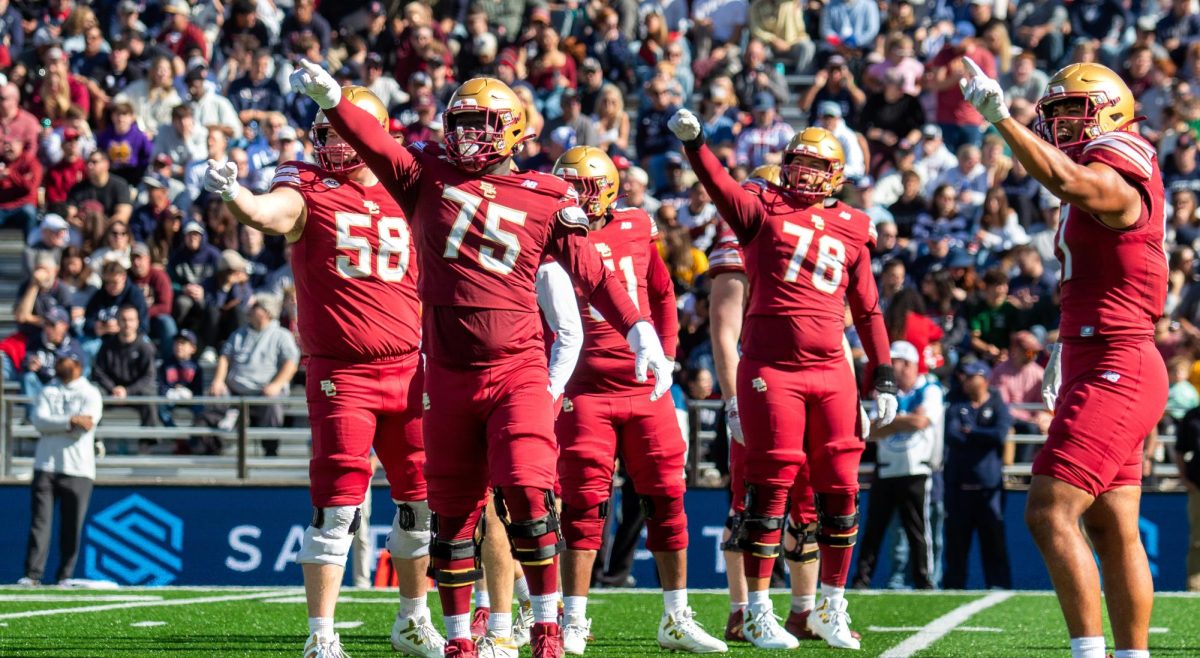It seems as if the only debate over incoming Director of Athletics Martin Jarmond is whether his hire was a home run or a grand slam.
The entire Boston College community was hyped when Jarmond was announced as Brad Bates’ replacement, and for good reason—his resume is remarkable for any AD candidate, let alone a 37-year-old. As Gene Smith’s right-hand man at Ohio State in charge of football operations and scheduling, Jarmond knows the inner-workings of a perennial football powerhouse. He led record-setting fundraising campaigns at both OSU and Michigan State. And he seems like an ideal fresh face to guide the athletic department through a period of change as it attempts to catch up with the rest of the ACC.
Safe to say, Jarmond will have plenty on his plate when he arrives to campus on Monday. Imagine all the new names he’ll have to remember, all the necessary networks he’ll have to develop in his first few weeks on the Heights. To call it overwhelming would be an understatement.
In the midst of all the chaos, though, Jarmond will be forming his vision for the direction of the program. Here are a few things I’d like to see him address in his first 100 days in office.
Be transparent about the future of smaller programs.
Bates left behind a solid foundation for new athletic facilities, but questions remain. Namely, how is the swim and dive team supposed to compete without a regulation-size diving board? Under Bates, the fate of the program was up in the air, creating a tension that reportedly forced out former head coach Tom Groden after 45 years at BC. Jarmond can mend these wounds by altering the plans for the new Plex. After all, they’re merely blueprints.
Or he can continue course and go forward with a $200 million project that will likely damage swim and dive, along with tennis and fencing. Design plans indicate that the number of tennis courts will drop from 10 to three, and available practice space for the fencing team will shrink. But maybe it’s the future that Jarmond sees for his new home. Streamlining the athletic department at the expense of smaller sports like swim and dive, tennis, and fencing may be one of the solutions to the struggles of football and men’s basketball.
Track and field, too, has suffered from a lack of proper facilities. As the only Beanpot school without a regulation indoor track, the Eagles are forced to train at Harvard, and that’s unlikely to change anytime soon. The new Plex outlines plans for a jogging track that sounds a lot like BC’s lone, disappointing indoor track that surrounds the tennis courts.
Again, Jarmond will have to face the question of whether to invest in a small sport or not. And if he decides that track and field is here to stay, then the next step is making sure the program catches up with the rest of Boston, let alone the ACC.
Either way, Jarmond should be open about the future of swim and dive and other similar sports, considering that new facility plans threaten their existence. The coaches and players deserve to hear the truth rather than discover it hidden in blueprints.
Improve the stadium plans for Brighton Campus facilities.
The long-awaited move to Brighton is on the horizon for Birdball and softball, but the new stadium might still be the worst in the ACC. Current plans show no signs of locker rooms, batting cages, or any other indoor practice facilities. Plus, the seating capacity was downgraded from 1,500 to just 1,000. If you’re going to spend millions of dollars on renovations, you might as well make sure they meet the standard of the ACC. And if anyone deserves state-of-the-art facilities, it’s head coach Mike Gambino and the Eagles, which have suffered through years of snowy Shea Field and sharing the Bubble in the offseason.
Finalize plans for a basketball practice facility.
Last spring, Bates announced three major construction projects—a rec center, playing fields, and a field house next to Alumni Stadium—that represented a step in the right direction despite some of the concerns discussed earlier. But one of the biggest omissions from the design plans was a separate practice facility for the basketball team. The Power Gym doesn’t exactly woo potential recruits. BC won’t truly be up to speed with the rest of its conference until it can boast respectable training facilities.
With a $200 million project already in the works, I understand that it may be difficult to fit another basketball complex into the equation. But it can’t be ignored. High on Jarmond’s list of priorities should be finding a location for a future basketball practice facility and securing funding for it.
Reinvigorate the alumni base of donors.
This should be the easiest of Jarmond’s tasks as he takes the reins in Chestnut Hill. The 37-year-old oozes charisma, and the community has already rallied around him in the days since his hire. Will fundraising at BC be harder than at OSU or MSU? Probably. The Eagles are nowhere near the Buckeyes or Spartans in terms of public support of their programs. But there is an alumni base out there that has been alienated by the struggles of BC’s biggest sports, and Jarmond has an opportunity to rope them in with hopeful rhetoric. There is a lot to be excited about for the future of the program. Jarmond just needs to sell his vision to donors and pray that they buy in.
It is far easier said than done, but if Jarmond can shore up the design plans for future facilities and continue his fundraising success, his impact will be more significant than any AD since the legendary Bill Flynn.
Featured Image by Julia Hopkins / Heights Editor













